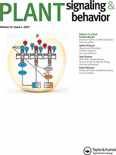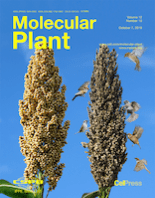
JOURNAL OF EXPERIMENTAL BOTANY
Scope & Guideline
Leading the charge in plant science discoveries.
Introduction
Aims and Scopes
- Plant Physiology and Development:
The journal covers fundamental aspects of plant physiology, including growth, development, and responses to environmental stimuli. Research often explores hormone signaling, metabolic pathways, and the genetic control of development. - Plant Stress Responses:
A significant area of focus is on how plants respond to various stresses, including abiotic stresses like drought, salinity, and temperature extremes, as well as biotic stresses from pathogens and pests. Studies investigate physiological, molecular, and genetic mechanisms underlying stress tolerance. - Molecular and Cellular Biology:
Research articles frequently delve into the molecular and cellular mechanisms that govern plant functions, including gene expression, protein interactions, and cellular signaling pathways. This includes the role of transcription factors and post-transcriptional modifications. - Plant-Microbe Interactions:
The journal emphasizes studies on plant-microbe interactions, including symbiotic relationships (e.g., mycorrhizae and rhizobia) and pathogen resistance. Research often investigates the genetic and biochemical basis of these interactions. - Ecophysiology and Environmental Interactions:
Research exploring how plants interact with their environment, including studies on nutrient uptake, water relations, and the effects of climate change on plant health and productivity. - Plant Biotechnology and Genetics:
The journal includes advancements in plant biotechnology, including genetic engineering, genome editing (e.g., CRISPR), and the development of biotechnological applications aimed at improving crop yield and resilience.
Trending and Emerging
- Plant Resilience and Climate Adaptation:
There is an increasing emphasis on understanding how plants adapt to climate change-related stresses, including drought, heat, and salinity. Research in this area focuses on genetic, physiological, and biochemical mechanisms that enhance plant resilience. - Molecular Mechanisms of Plant Immunity:
Studies investigating the molecular basis of plant immune responses to pathogens are on the rise. This includes research on signaling pathways, receptor interactions, and the role of secondary metabolites in defense. - Microbiome Interactions and Plant Health:
Emerging research on plant-associated microbiomes and their influence on plant health and stress resistance is gaining traction. This includes studies on how microbial communities interact with plant roots and affect nutrient uptake. - Synthetic Biology and Genetic Engineering:
There is a notable trend towards using synthetic biology approaches to engineer plants for improved traits, including stress tolerance and enhanced nutritional value. This includes advancements in gene editing technologies. - Ecophysiology and Nutrient Dynamics:
Research focusing on plant responses to nutrient availability and its impact on growth and development is emerging. This trend reflects an increased interest in the interplay between plant physiology and environmental factors. - Photosynthesis Research and Optimization:
A growing body of work is dedicated to understanding and optimizing photosynthesis in plants, particularly in the context of improving crop yields under varying environmental conditions.
Declining or Waning
- Traditional Taxonomy and Systematics:
Research focused on classical plant taxonomy and systematics appears to be waning as the field increasingly prioritizes molecular and genomic approaches. The emphasis has shifted towards understanding genetic relationships and evolutionary biology rather than purely descriptive taxonomy. - Historical Botany:
Studies dedicated to historical aspects of botany, such as the history of plant use or ethnobotany, are less frequently published, possibly overshadowed by more experimental and application-oriented research. - Basic Morphology Studies:
While morphology remains important, publications focusing solely on descriptive morphology without experimental context have decreased, as there is a growing trend towards integrating morphology with molecular data and functional studies. - Invasive Species Research:
Research specifically centered on invasive plant species has become less prominent in recent issues, perhaps due to a shift towards more applied ecological studies and conservation strategies that encompass broader ecological impacts.
Similar Journals

JOURNAL OF PLANT BIOCHEMISTRY AND BIOTECHNOLOGY
Bridging Research and Application in Crop ScienceJOURNAL OF PLANT BIOCHEMISTRY AND BIOTECHNOLOGY, published by SPRINGER INDIA, is a leading publication dedicated to advancing research in the fields of plant biochemistry, biotechnology, agronomy, and crop science. With an ISSN of 0971-7811 and E-ISSN 0974-1275, the journal encompasses a wide range of studies aimed at enhancing our understanding of plant biological processes and their applications in agriculture and biotechnology. It has achieved a noteworthy Q2 ranking in Agronomy and Crop Science and Plant Science, as well as a Q3 ranking in Biotechnology, reflecting its quality and relevance in contemporary research. Notably, the journal ranks #166 in Plant Science and #133 in Agronomy, both falling in the top 67th percentile. With a rich history spanning from 1992 to 2024, the journal is committed to providing open access to innovative research findings that bridge the gap between laboratory discoveries and their practical applications in sustainable agriculture. Researchers, professionals, and students will find a wealth of knowledge and inspiration to advance their work in the dynamic field of plant sciences at this esteemed journal.

JOURNAL OF PLANT RESEARCH
Nurturing Insights for a Greener Future.JOURNAL OF PLANT RESEARCH, published by SPRINGER JAPAN KK, is a leading academic journal that has carved a niche in the field of Plant Science. With its ISSN 0918-9440 and E-ISSN 1618-0860, this journal has been disseminating high-quality research since its inception in 1993 and continues to be essential reading for academics and practitioners alike, aiming to bridge the gap between innovative plant research and practical applications. The journal is highly regarded, holding a prestigious Q1 ranking in Plant Science for 2023, and is positioned in the top 80th percentile within the Scopus rankings for Agricultural and Biological Sciences. The journal's coverage includes a wealth of topics pertinent to advancing our understanding of plant biology, ecology, and sustainable agricultural practices. Although it operates under a subscription model, its influence in the research community remains profound, making it a vital resource for contemporary studies in plant-related disciplines.

JOURNAL OF PLANT BIOLOGY
Leading the Way in Plant Science ExcellenceJOURNAL OF PLANT BIOLOGY, published by SPRINGER HEIDELBERG, is a leading academic journal dedicated to advancing the field of plant science. With an impressive impact factor signifying its high citation rate and rigorous peer-review process, this journal ranks in the Q1 category within Plant Science, placing it among the top-tier periodicals in the discipline. Established in 1999, it has become an essential resource for researchers, professionals, and students seeking the latest findings and developments in plant biology. The journal fosters a collaborative environment for sharing innovative research, exploring ecological interactions, and understanding plant physiology, thereby contributing significantly to advancements in sustainable agriculture and environmental conservation. Its high Scopus ranking of 102 out of 516 in the category of Agricultural and Biological Sciences further underscores its relevance and impact within the scientific community. For those interested in cutting-edge research, JOURNAL OF PLANT BIOLOGY is a vital source of knowledge, offering insights that are crucial for the future of plant science.

Horticulturae
Exploring the Frontiers of Plant Research.Horticulturae, an esteemed open-access journal published by MDPI, is at the forefront of horticultural science, showcasing innovative research and advancements in the field since its inception in 2015. With its base in Switzerland, this journal operates under the ethos of global accessibility, allowing researchers, professionals, and students to share and disseminate critical findings without barriers. Horticulturae holds a distinguished Q1 ranking in Horticulture and Q2 in Plant Science, as reported in the 2023 categorizations, highlighting its impactful contributions to the scientific community. The journal features rigorous peer-reviewed articles covering a wide range of topics, including plant physiology, crop production, and sustainable practices, making it a vital resource for anyone engaged in gardening, agronomy, and environmental science. As it converges its focus from 2015 to 2024, Horticulturae not only aims to further academic discourse but also aligns with the growing need for research pertaining to biodiversity and sustainable agriculture, thus ensuring relevance in an ever-evolving field.

PROTOPLASMA
Cultivating Knowledge in Cell Biology and Plant SciencePROTOPLASMA is a prestigious academic journal published by Springer Wien, dedicated to advancing knowledge in the fields of Cell Biology, Plant Science, and related areas of Medicine. Established in 1926 and continuing through 2024, this journal boasts a rich history of scholarly contributions and is currently indexed with a notable ranking in various disciplines: it stands in the top quartile (Q1) in Plant Science, the second quartile (Q2) in miscellaneous Medicine, and the third quartile (Q3) in Cell Biology as of 2023. With robust Scopus rankings placing it in the 86th percentile in Plant Science and a solid position in Cell Biology, PROTOPLASMA is recognized for its commitment to high-quality research and innovative findings. Although the journal does not offer open access options, it remains a valuable resource for researchers, professionals, and students seeking to explore the cellular and molecular underpinnings of plant life and its implications in broader biological contexts. Based in Austria, PROTOPLASMA serves as a vital forum for disseminating pioneering research that shapes the future of scientific inquiry in its respective fields.

Annual Review of Plant Biology
Connecting Research and Discovery in Plant BiologyThe Annual Review of Plant Biology, published by Annual Reviews, stands as a premier academic journal dedicated to the comprehensive coverage of significant developments in the field of plant biology. With an impactful presence in the United States and a stellar reputation reflected in its Q1 rankings across multiple categories including Cell Biology, Molecular Biology, Physiology, and Plant Science, this journal consistently ranks among the top within its domain. The journal is particularly esteemed for its synthesis of the latest research findings, making it an invaluable resource for researchers, professionals, and students seeking in-depth insights and advancements in plant biology. Though it does not offer open access, the Annual Review of Plant Biology is essential for those committed to exploring the intricate mechanisms underlying plant function and development, with coverage spanning from 1996 to 2024. As the field continues to evolve, this journal will undoubtedly remain at the forefront, driving innovation and fostering a deeper understanding of plant sciences.

BIOLOGIA PLANTARUM
Innovative Research, Rooted in TraditionBIOLOGIA PLANTARUM, esteemed within the realms of horticulture and plant science, is a leading academic journal published by the Academy of Sciences of the Czech Republic, Institute of Experimental Botany. Established in 1959, this journal showcases innovative research and advancements in plant biology, focusing on a spectrum of topics including plant physiology, genetics, and biotechnology. With an impressive Scopus ranking in Horticulture (Rank #41/115) and Plant Science (Rank #221/516), it holds a significant place in the academic community, reflected in its Q2 and Q3 status within its respective categories. Although it is not open access, authors are encouraged to contribute to the growing body of knowledge that supports sustainable practices in agriculture and horticulture. Published in the Netherlands, BIOLOGIA PLANTARUM continues to foster collaboration and dialogue among researchers, professionals, and students dedicated to understanding and advancing plant sciences.

Plant Signaling & Behavior
Bridging Science and Nature: The Language of PlantsPlant Signaling & Behavior is a prestigious journal published by TAYLOR & FRANCIS INC, dedicated to advancing the understanding of the complex signaling mechanisms and behavioral responses of plants. With an ISSN of 1559-2316 and an E-ISSN of 1559-2324, it has firmly established itself in the field of Plant Science, earning a Q1 ranking in the 2023 category quartiles and ranking #83 out of 516 in Agricultural and Biological Sciences, placing it in the 84th percentile according to Scopus metrics. The journal serves as a vital platform for researchers and professionals looking to publish innovative studies and reviews that explore the intricate relationships between plant behavior and environmental signaling. With coverage spanning from 2006 to 2024, Plant Signaling & Behavior not only enhances academic discourse but also supports the growing interdisciplinary nature of plant sciences. Although the journal is not open access, it remains a significant resource for students, researchers, and practitioners aiming to deepen their understanding of plant signaling and its implications for ecology and agricultural practices.

Journal of Integrative Plant Biology
Unveiling the Complexities of Plant LifeThe Journal of Integrative Plant Biology, published by WILEY, is a premier academic journal that has been at the forefront of advancing research in plant biology since its inception in 2005. With a notable impact factor and a robust Scopus ranking—positioned at #7 out of 516 in Plant Science and #18 out of 438 in Biochemistry—this journal is recognized as a Q1 journal in multiple categories, including Biochemistry and Plant Science. The journal aims to bridge the gaps between various disciplines in plant research, emphasizing integrative and interdisciplinary approaches to understanding plant biology. With options for open access, the Journal of Integrative Plant Biology ensures broad visibility and impact of research findings, making it an invaluable resource for researchers, professionals, and students looking to stay informed on innovative advancements in the field. Its headquarters are located in the United Kingdom, further amplifying its reach within the global academic community.

Molecular Plant
Exploring the frontiers of molecular biology in plants.Molecular Plant, published by CELL PRESS, is a premier journal dedicated to advancing the field of molecular biology and plant science. With an impressive impact factor reflecting its rigorous peer-review process and the high quality of its published research, this journal has achieved a remarkable Q1 ranking in both Molecular Biology and Plant Science categories as of 2023. Its Scopus rankings place it within the top echelons of its field, holding 2nd place in Agricultural and Biological Sciences - Plant Science, showcasing its vital role in disseminating impactful research. The journal covers a broad range of topics, including but not limited to, plant genetics, molecular interactions, and biotechnological advances. Research published in Molecular Plant has the potential to significantly influence agricultural practices and biotechnological applications, making it an essential resource for researchers, professionals, and students eager to stay at the forefront of plant research. Access options for the journal are tailored to accommodate a wide audience, facilitating engagement with cutting-edge findings and breakthroughs. As the field of plant science continues to evolve, Molecular Plant remains integral to fostering innovation and collaboration within the scientific community.